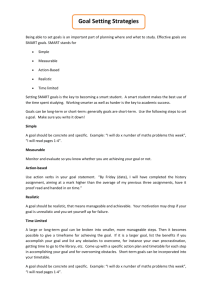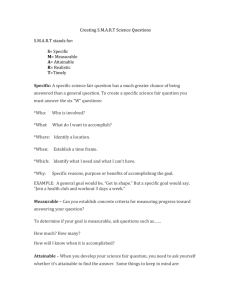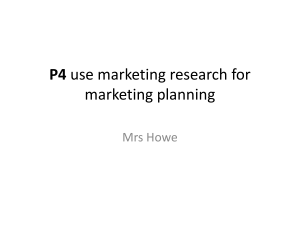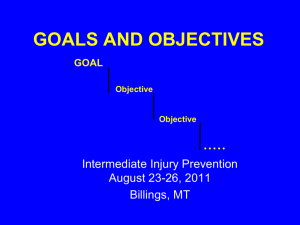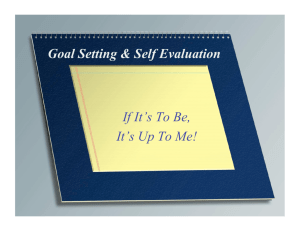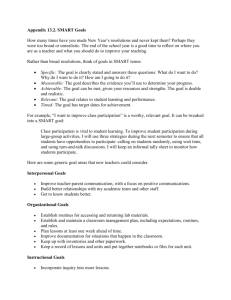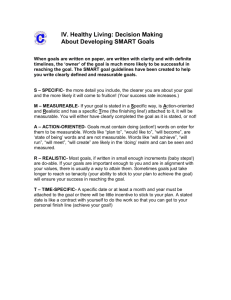SMART Learning Goals: Training & Exercises
advertisement
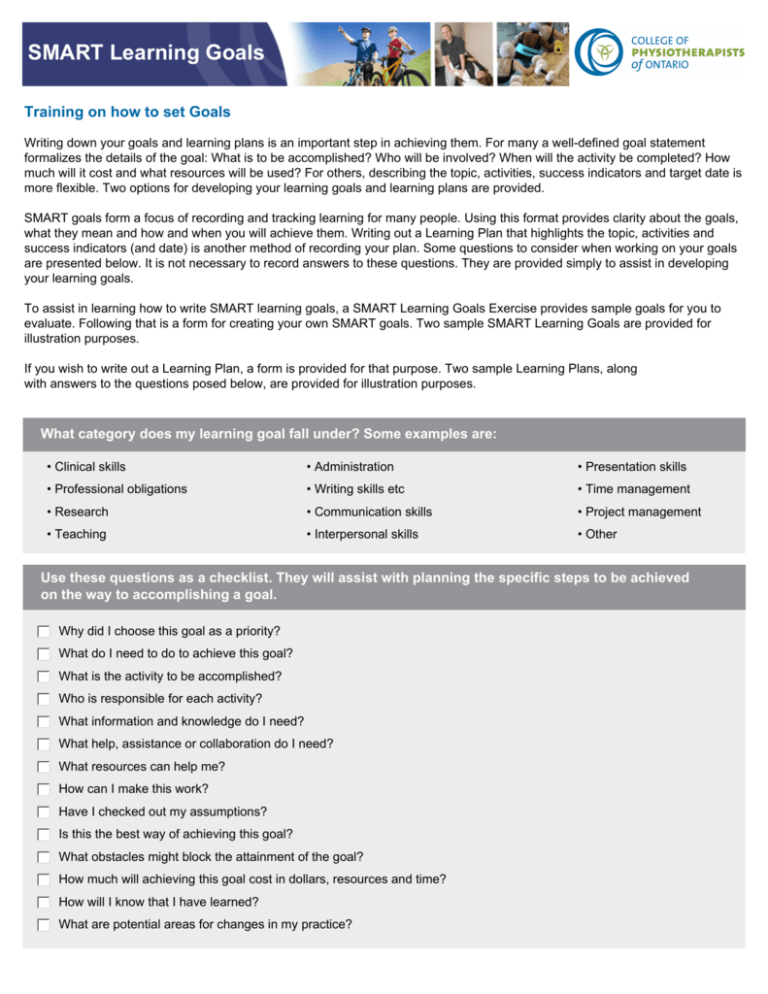
SMART Learning Goals Training on how to set Goals Writing down your goals and learning plans is an important step in achieving them. For many a well-defined goal statement formalizes the details of the goal: What is to be accomplished? Who will be involved? When will the activity be completed? How much will it cost and what resources will be used? For others, describing the topic, activities, success indicators and target date is more flexible. Two options for developing your learning goals and learning plans are provided. SMART goals form a focus of recording and tracking learning for many people. Using this format provides clarity about the goals, what they mean and how and when you will achieve them. Writing out a Learning Plan that highlights the topic, activities and success indicators (and date) is another method of recording your plan. Some questions to consider when working on your goals are presented below. It is not necessary to record answers to these questions. They are provided simply to assist in developing your learning goals. To assist in learning how to write SMART learning goals, a SMART Learning Goals Exercise provides sample goals for you to evaluate. Following that is a form for creating your own SMART goals. Two sample SMART Learning Goals are provided for illustration purposes. If you wish to write out a Learning Plan, a form is provided for that purpose. Two sample Learning Plans, along with answers to the questions posed below, are provided for illustration purposes. What category does my learning goal fall under? Some examples are: • Clinical skills • Administration • Presentation skills • Professional obligations • Writing skills etc • Time management • Research • Communication skills • Project management • Teaching • Interpersonal skills • Other Use these questions as a checklist. They will assist with planning the specific steps to be achieved on the way to accomplishing a goal. Why did I choose this goal as a priority? What do I need to do to achieve this goal? What is the activity to be accomplished? Who is responsible for each activity? What information and knowledge do I need? What help, assistance or collaboration do I need? What resources can help me? How can I make this work? Have I checked out my assumptions? Is this the best way of achieving this goal? What obstacles might block the attainment of the goal? How much will achieving this goal cost in dollars, resources and time? How will I know that I have learned? What are potential areas for changes in my practice? Exercise 1: Is the Goal Specific? This form provides an exercise to assist you in identifying the components of goal statements and determining whether they are SMART goals. Specific means detailed and focused. Everyone reading it should know exactly what is to be achieved and accomplished. How Specific is the goal? Rate the following statements. Are they specific enough to spell out the details of the goal? (Answers provided below.) Goal Statement Is My Goal Specific? Too General Specific Enough a) To use appropriate resources to increase patient independence. b) To take measurements for custom made orthotics. c) To learn a few words and phrases in Spanish to be able to communicate better with my clients. d) To know and learn more about whiplash injuries (Cervical spine, Lumber spine). e) To learn more about using fitness gym equipment for upper and lower extremity sports injuries. f ) To learn more about acute injury and on-site treatment for injured workers. g) To get updated on the most recent literature in the treatment of musculoskeletal injuries. h) To increase knowledge about risks/causes, prevention and treatment related to skin breakdown of inpatients. i) To have a paper accepted for presentation in the future. j) To improve goal setting with clients. Answers Answers Exercise 2: Is the Goal Measurable? Measurable goals are quantifiable. They provide a standard. Being “better” is too ambiguous. How do you know when you are “better”? What is enough? Which of the following are Measurable? (Answers provided below.) Is My Goal Measurable? Yes No Goal Statement a) To complete and record brief comprehensive multi-dimension assessments of the elderly client. b) To prepare and present an overview of sports injuries to a group of fitness club members. c) To learn more about current surgery and rehab concepts in the treatment of anterior cruciate ligaments. d) To pass the McKenzie credentialing exam. e) To learn how to incorporate biofeedback into my treatments. f ) To expand my knowledge and understanding of ALS. g) To complete the level 1 Acupuncture examination in 2004. Answers Exercise 3: Does the Goal use an Action Verb? Action verbs tell you what the activity is that will be carried out. List some action verbs: Answers Exercise 4: Is the Goal Realistic? Realistic goals are practical and achievable. A goal should stretch you, but not so far that you will be discouraged before you even start. Are the following Realistic or unrealistic? (Answers provided below.) Goal Statement Is My Goal Realistic? Yes No a) To introduce new equipment that will improve client outcomes and satisfaction. b) To understand the effects of medications injuries on a group of fitness club members. c) To become an expert clinician within 12 months. d) To complete the Intermediate Diploma of Manual and manipulative Physiotherapy (CPA Orthopaedic Division) within 12 months. e) To update clinical skills in all areas. f ) To speak Spanish fluently by the end of the community college language course. g) To learn two new treatments for strokes. h) To improve clinical reasoning skills related to shoulder injuries. i) To improve lower extremity manual therapy skills. j) To improve goal setting with clients. Whether a goal is realistic or not will, of course, depend on the people and circumstances involved. But based on certain assumptions and generalities, here are the responses to these goals. Answers Answers *Note: d may be realistic for an individual who has completed the majority of the coursework, but unrealistic for an individual who has not started any of the course work Exercise 5: Does the Goal have a Time Line? Time-resource-constrained goals have identified timelines and resources needed. Timelines encourage action and deadlines encourage activity. These help you evaluate your progress and motivate you to move along towards your goal. Which of the following are deadlines and which are expressions of Time? (Answers provided below.) Goal Statement Is My Goal Realistic? Yes No a) On a continuous basis b) By the end of the fiscal year c) By December 31, 2012 d) By the end of 6 months e) As soon as possible f ) By April 30, 2012 g) By the end of the surgical rotation h) Next week i) First thing Monday morning Answers *Note: i looks time-constrained, but “first thing” can mean different things to different people. Answers Component of Goal Description of Component S Specific Enough details are present to provide a clear picture of what is desired. M Measurable The goal must be measurable or you won't know when you have achieved it. A Action-oriented The details of what you are to do are clear. R Relevant/ Realistic T Timebound My Goal Components The goal is applicable to your current role or another role you are planning on taking on. A timeline is associated with the goal. Completed Goal Statement Remember to: ✔ Express your goals positively ✔ Record your goals ✔ Prioritize your goals Clear Form Print

